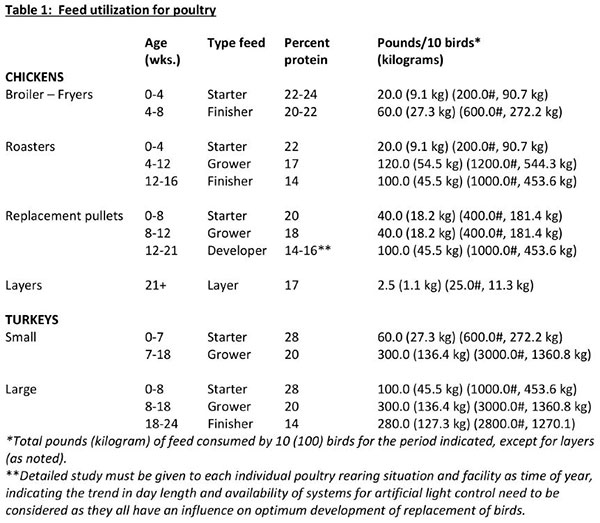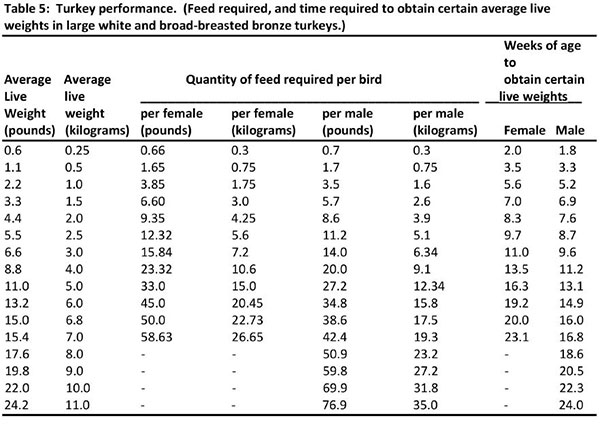by Howard Enos* (12/19)
Quick Facts…
- Providing a balanced nutritious diet and plenty of water is critical to keeping a healthy flock.
- Using a pre-mixed feed may be the easiest system for small flock owners.
- Your bird’s nutritional needs will vary with age and whether you are raising them foregg or meat production.
It is important to maintain health and productivity of poultry through proper nutrition. Birds need a series of nutrients which are found in the various feed ingredients. These nutrients include macronutrients (proteins, carbohydrates and fats), micronutrients (minerals and vitamins) and water. Water is not usually considered as a nutrient, but its importance must always be emphasized. There are several systems of feeding: free-choice or “cafeteria style” feeding of mash and grain, controlled feeding of mash and grain, feeding all mash, or other combinations of a complete feed.
Each system should accommodate the specific needs of your flock, and be designed for flexibility, low maintenance, and reliability to keep installation and operating costs low. The choice of one of these feeding systems will depend mainly upon the size of the flock and the labor and equipment available. Success with any system depends on the feed supply, equipment, management and individual practices. The likelihood of disease and/or nutritional problems will be minimized if good sanitation, adequate housing, equipment and daily care are emphasized. Regardless of the quality of chicks purchased, good results cannot be expected unless chicks are fed a nutritious diet. Free choice allows birds to balance or regulate their intake of grain and mash. The freechoice system can work well with small flocks but leaves too much guesswork for a commercial flock. There are, however, general recommendations for feeding replacement chicks, layers, broilers and turkeys.
Controlled mash and grain feeding is used successfully in small flocks. More care and attention must be given to the flock fed this way than the flock fed with all-mash. Controlled mash and grain feeding involves the use of a concentrate (20 to 23 percent protein), and limited amounts of whole grains and calcium supplement. The amount of grain fed should be calculated to make the total feed intake contain about 16 percent protein. Slight adjustments can be made seasonally to provide more energy in cold weather (more grain) and to provide less energy in hot weather (less grain). Grains may be placed in hoppers or scattered in the litter.
The all-mash system is by far the most common. This is especially true for commercial size flocks. The proper nutritional balance is taken care of by man rather than letting the hen balance her own ration. In larger flocks this ensures against the possibility that the hen will not do a good job of balancing her own ration. All-mash feeding involves the use of a single mash which contains all components of a balanced ration. Egg quality actors, such as shell thickness and yolk color, are more uniform and more easily controlled with this system. An all-mash ration can be easily dispensed in hanging or automatic feeders. Less skill on the part of the flock owner is required with the all-mash system. A calcium supplement such as crushed oyster shell or limestone granules can be made available freechoice, if desired. Also, a portion (1 / 2 or 2/ 3) of the calcium supplement in the ration may be larger particle size limestone or oyster shell. Calcium supplements that are larger take longer to move through the digestive system and therefore more calcium is absorbed. Small particle size supplements move quickly through the digestive system and less calcium is released into the bloodstream.
A complete ration purchased from a local feed supplier will be the most easily managed, and the likelihood of disease risk and/or nutritional problems will be minimized if good sanitation, adequate housing, equipment and daily care are emphasized. The actual feed requirement for any group or flock will vary depending upon many factors. However, the figures listed below can be followed as the best estimate of feed utilizations. Weights are based on 10 birds with weights for 100 birds in parenthesis.
When using a commercial feed, the manufacturer’s feeding recommendations should be followed explicitly. Avoid mixing recommendations of several different companies because each manufacturer designs their product for a specific feeding program.
Feed form – either mash, crumbles or pellets – are other considerations and each has its specific advantage and disadvantage and varies for optimum utility among the various ages and poultry species. In short, there is not one best answer to a correct choice: however, mash is generally the most economical feed store purchase.
No one feeding system is the best – the choice is an individual one. Generally, commercial producers follow the all-mash system, while families with backyard poultry enterprises and hobby poultry producers generally follow either the free choice or controlled mach and grain feeding system.










